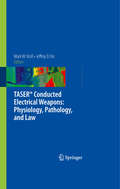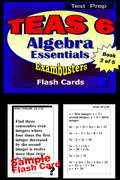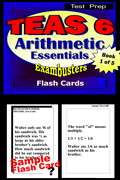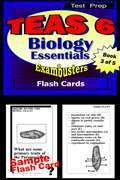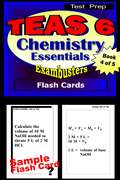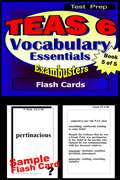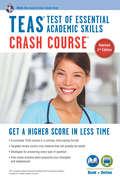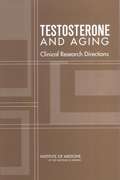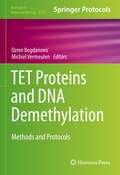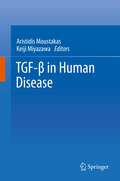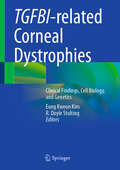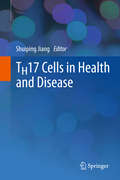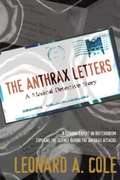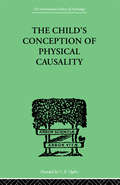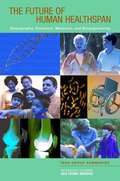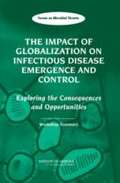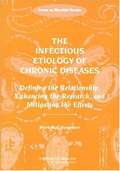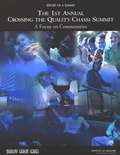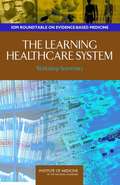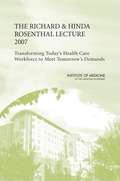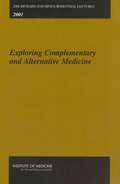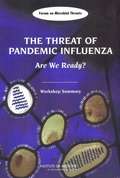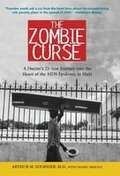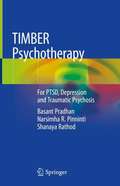- Table View
- List View
T1-Mapping in Myocardial Disease: Principals And Applications
by Phillip C. YangThis book details the advances in cardiac MRI that have enabled quantitative tissue characterization of the myocardium using myocardial and blood T1 measurements, which have enabled reliable detection of diffuse pathological processes in both the cardiomyocytes and the interstitial cells of the myocardium. Evaluation of the native myocardial and interstitial fibrosis, and measurement of the extracellular volume fraction has allowed an unprecedented opportunity to elucidate the pathology, diagnosis and prognosis of cardiovascular disease. T1-Mapping in Myocardial Disease: Principles and Applications reviews a wide spectrum of significant cardiovascular disease and provides relevant guidance for the clinical implementation of this innovative technique. The specific topics covered include principles of T1-mapping in cardiovascular disease and the role of T1-mapping in hypertensive heart disease and hypertrophic cardiomyopathy, cardiotoxicity from cancer treatment, cardiacfibrosis, left ventricular hypertrophy in aortic stenosis, peri-infarct injury in ischemic cardiomyopathy, and stem cell therapy. This comprehensive coverage of the utility of T1-mapping in cardiovascular diseases will greatly appeal to the entire cardiovascular medicine and imaging communities.
TASER® Conducted Electrical Weapons: Physiology, Pathology, and Law
by Jeffrey D. Ho Mark W. KrollTASER® Conducted Electrical Weapons are rapidly replacing the club for law-enforcement control of violent subjects within many countries around the globe. A TASER CEW is a hand-held device that delivers a 400-volt pulse with a duration tuned to control the skeletal muscles without affecting the heart at a distance of up to 6.5 meters over tiny wires. If necessary, it begins with an arcing voltage of 50,000 V to penetrate thick clothing; the 50,000 V is never delivered to the body itself. Due to the widespread usage of these devices and the widespread misconceptions surrounding their operation, this book will have significant utility. This volume is written for cardiologists, emergency physicians, pathologists, law enforcement management, corrections personnel, and attorneys.
TEAS 6 Test Prep Flash Cards: Algebra Essentials (Exambusters TEAS 6 Workbook #2 of 5)
by Ace Inc.<P><P><i>Advisory: Bookshare has learned that this book offers only partial accessibility. We have kept it in the collection because it is useful for some of our members. Benetech is actively working on projects to improve accessibility issues such as these.</i><P><P> 450 questions and answers that highlight introductory algebra definitions, problems, and concepts. <P><P>Topics: Algebraic Concepts, Sets, Variables, Exponents, Properties of Numbers, Simple Equations, Signed Numbers, Monomials, Polynomials, Additive and Multiplicative Inverse, Word Problems, Prime Numbers, Factoring, Algebraic Fractions, Ratio and Proportion, Variation, Radicals, Quadratic Equations<P>Exambusters TEAS 6 Prep Workbooks provide comprehensive, fundamental TEAS V review--one fact at a time--to prepare students to take practice TEAS V tests. Each TEAS V study guide focuses on one specific subject area covered on the TEAS V exams. From 300 to 600 questions and answers, each volume in the TEAS V series is a quick and easy, focused read. Reviewing TEAS V flash cards is the first step toward more confident TEAS V preparation and ultimately, higher TEAS V exam scores!
TEAS 6 Test Prep Flash Cards: Arithmetic Essentials (Exambusters TEAS 6 Workbook #1 of 5)
by Ace Inc.<P><P><i>Advisory: Bookshare has learned that this book offers only partial accessibility. We have kept it in the collection because it is useful for some of our members. Benetech is actively working on projects to improve accessibility issues such as these.</i><P><P> 600 questions and answers highlight essential arithmetic definitions, problems, and concepts.<P><P> Topics: Addition, Subtraction, Multiplication, and Division of Whole Numbers; Fractions and Decimals, Multiplication Tables, Word Problems, Percents, Measurement, Metric System, Square Roots and Powers, Real Numbers, Properties of Numbers <P>Exambusters TEAS 6 Prep Workbooks provide comprehensive, fundamental TEAS V review--one fact at a time--to prepare students to take practice TEAS V tests. Each TEAS V study guide focuses on one specific subject area covered on the TEAS V exams. From 300 to 600 questions and answers, each volume in the TEAS V series is a quick and easy, focused read. Reviewing TEAS V flash cards is the first step toward more confident TEAS V preparation and ultimately, higher TEAS V exam scores!
TEAS 6 Test Prep Flash Cards: Biology Essentials (Exambusters TEAS 6 Workbook #3 of 5)
by Ace Inc.<P><P><i>Advisory: Bookshare has learned that this book offers only partial accessibility. We have kept it in the collection because it is useful for some of our members. Benetech is actively working on projects to improve accessibility issues such as these.</i><P><P> 450 questions and answers. Essential definitions and concepts. <P><P>Topics: Cells, Biochemistry and Energy, Evolution and Classification, Kingdoms: Bacteria, Fungi, Protista; Kingdom: Plantae, Kingdom: Animalia, Human Locomotion, Human Circulation and Immunology, Human Respiration and Excretion, Human Digestion, Human Nervous System, Human Endocrinology, Reproduction and Development, Genetics, Ecology <P>Exambusters TEAS 6 Prep Workbooks provide comprehensive, fundamental TEAS V review--one fact at a time--to prepare students to take practice TEAS V tests. Each TEAS V study guide focuses on one specific subject area covered on the TEAS V exams. From 300 to 600 questions and answers, each volume in the TEAS V series is a quick and easy, focused read. Reviewing TEAS V flash cards is the first step toward more confident TEAS V preparation and ultimately, higher TEAS V exam scores!
TEAS 6 Test Prep Flash Cards: Chemistry Essentials (Exambusters TEAS 6 Workbook #4 of 5)
by Ace Inc.<P><P><i>Advisory: Bookshare has learned that this book offers only partial accessibility. We have kept it in the collection because it is useful for some of our members. Benetech is actively working on projects to improve accessibility issues such as these.</i><P><P> 700 questions and answers. Essential definitions, formulas, concepts, and sample problems. <P><P>Topics: Introduction, Matter, Atoms, Formulas, Moles, Reactions, Elements, Periodic Table, Electrons, Chemical Bonds, Heat, Gases, Phase Changes, Solutions, Reaction Rates, Equilibrium, Acids and Bases, Oxidation and Reduction, Introduction to Organic Chemistry, Radioactivity <P>Exambusters TEAS 6 Prep Workbooks provide comprehensive, fundamental TEAS V review--one fact at a time--to prepare students to take practice TEAS V tests. Each TEAS V study guide focuses on one specific subject area covered on the TEAS V exams. From 300 to 600 questions and answers, each volume in the TEAS V series is a quick and easy, focused read. Reviewing TEAS V flash cards is the first step toward more confident TEAS V preparation and ultimately, higher TEAS V exam scores!
TEAS 6 Test Prep Flash Cards: Vocabulary Essentials (Exambusters TEAS 6 Workbook #5 of 5)
by Ace Inc.<P><P><i>Advisory: Bookshare has learned that this book offers only partial accessibility. We have kept it in the collection because it is useful for some of our members. Benetech is actively working on projects to improve accessibility issues such as these.</i><P><P> 350 frequently tested words every college graduate should know. Perfect for anyone who wants to enrich their vocabulary! Improve your reading comprehension and conversation. Includes sample sentence, part of speech, pronunciation, succinct, easy-to-remember definition, and common synonyms and antonyms. <P><P>Exambusters TEAS 6 Prep Workbooks provide comprehensive, fundamental TEAS V review--one fact at a time--to prepare students to take practice TEAS V tests. Each TEAS V study guide focuses on one specific subject area covered on the TEAS V exams. From 300 to 600 questions and answers, each volume in the TEAS V series is a quick and easy, focused read. Reviewing TEAS V flash cards is the first step toward more confident TEAS V preparation and ultimately, higher TEAS V exam scores!
TEAS Crash Course Book + Online (Nursing Test Prep)
by Daniel GreenbergREA's TEAS Crash Course Book + Online Practice Test Fully Revised Second EditionEverything you need for the exam - in a fast review format! REA's TEAS (Test of Essential Academic Skills) Crash Course is the first book of its kind for the last-minute studier or anyone who wants to get a high score on this nursing school entry exam. Targeted, Focused Review - Study Only What You Need to Know Based on the Test of Essential Academic Skills exam and actual TEAS questions, the Crash Course covers only the information tested on the exam, so you can make the most of your study time. Targeted, easy-to-read review chapters in outline format cover reading comprehension, English language and usage, math, biology, chemistry, physics, and more. Expert Test-taking Strategies Our author explains the structure of the TEAS, so you know what to expect on test day. He also shares detailed question-level strategies and shows you the best way to answer questions. By following our expert tips and advice, you can score higher on every section of the exam. Take REA's Online Practice Exam After studying the material in the TEAS Crash Course, go online and test what you've learned. Our practice exam features timed testing, diagnostic feedback, detailed explanations of answers, and automatic scoring analysis. The exam is balanced to include every topic and type of question found on the TEAS exam, so you know you're studying the smart way. No matter how or when you prepare for the TEAS exam, REA's TEAS Crash Course will show you how to study efficiently and strategically, so you can get a higher score in less time!
TESTOSTERONE AND AGING: Clinical Research Directions
by Institute of Medicine of the National AcademiesPopular culture often equates testosterone with virility, strength, and the macho male physique. Viewed by some as an “antiaging tonic,” testosterone’s reputation and increased use by men of all ages in the United States have outpaced the scientific evidence about its potential benefits and risks. In particular there has been growing concern about an increase in the number of middle-aged and older men using testosterone and the lack of scientific data on the effect it may have on aging males. Studies of testosterone replacement therapy in older men have generally been of short duration, involving small numbers of participants and often lacking adequate controls. Testosterone and Aging weighs the options of future research directions, examines the risks and benefits of testosterone replacement therapy, assesses the potential public health impact of such therapy in the United States, and considers ethical issues related to the conduct of clinical trials. Testosterone therapy remains an attractive option to many men even as speculation abounds regarding its potential.
TET Proteins and DNA Demethylation: Methods and Protocols (Methods in Molecular Biology #2272)
by Ozren Bogdanovic Michiel VermeulenThis volume explores the latest methods used to study various aspects of TET proteins and their biology. Chapters in this book are divided into five parts. Part One describes technologies aimed at detecting and quantifying DNA methylation turnover using massively parallel sequencing, ELISA, and mass spectrometry approaches. Part Two looks at data analyses protocols for distinguishing acting versus passive DNA demethylation and estimation of 5mC and 5hmC levels. Part Three deals with a new topic that takes advantage of modified CRISPR/Cas9 genome editing systems to target DNA demethylation activity to genomic loci of interest. Part Four discusses protocols that detail how to purify TET proteins and unravel their protein interactions, and Part Five looks at the assessment of TET protein function and activity in vivo and in vitro. Written in the highly successful Methods in Molecular Biology series format, chapters include introductions to their respective topics, lists of the necessary materials and reagents, step-by-step, readily reproducible laboratory protocols, and tips on troubleshooting and avoiding known pitfalls. Cutting-edge and thorough, TET Proteins and DNA Demethylation: Methods and Protocols is a valuable resource that aims to help research scientists at all levels working in the fields of DNA demethylation dynamics.Chapters 3, 7 and 17 are available open access under a Creative Commons Attribution 4.0 International License via link.springer.com.
TGF-β in Human Disease
by Aristidis Moustakas Keiji MiyazawaTransforming growth factor-β (TGF-β) is a secreted polypeptide with multifunctional properties manifested during embryonic development, adult organ physiology, and pathobiology of major diseases, including cancer and fibrotic and cardiovascular diseases. The signaling pathway of TGF-β now is rather well understood. Continuing revelations in the mechanisms of action of TGF-β provide specific mechanistic examples of how human cells lose their controlled function and behave wrongly during the development of diverse diseases. Equally important, however, is the current promise of exploiting the TGF-β pathway in combating human disease. This book comprehensively covers major areas of human disease where the involvement of TGF-β is firmly established. Simultaneously, the book highlights major gaps in knowledge and the future directions of research that can benefit human medical science. The core set of diseases where TGF-β action is well documented and are included in the book are cancer and cardiovascular and fibrotic disorders. The central aim of the book is to stimulate young scientists to enter the prolific TGF-β field and find new solutions to the problems remaining in this area of study. For this purpose the book provides authoritative educational chapters that furnish a good introduction to the field for young doctoral students, postdocs, and clinical fellows. The book also serves as a valuable reference for the aficionados in the field, who can find accessible and well-illustrated material for their teaching and lecturing activities, via which the importance of TGF-β biology is disseminated to the world of science and to the public.
TGFBI-related Corneal Dystrophies: Clinical Findings, Cell Biology, and Genetics
by Eung Kweon Kim R. Doyle StultingThis book provides up-to-date information about the basic cell biology, protein processing mechanisms, genetics, and treatment strategies for TGFBI-related corneal dystrophies. Extensive illustrations document the clinical appearance of these dystrophies, and details of their cell biology provide our current understanding of intracellular pathologic mechanisms related to the mutated TGFBI protein. Descriptions of metabolic pathways involving TGFBI protein include recent information about the intracellular processing of normal and mutated TGFBI proteins. Detailed descriptions of the pathologic basis for TGFBI-related corneal dystrophies and possible strategies for human gene therapy are provided. This book offers a rich source of information about the pathogenesis, diagnosis, and treatment options for practicing ophthalmologists, specialists, and trainees.
TH17 Cells in Health and Disease
by Shuiping Jiang"About 25 years ago, Mosmann & Coffman introduced the TH1 / TH2 paradigm of T helper cell differentiation which helped explain many aspects of adaptive immunity from eliminating intracellular versus extracellular pathogens to induction of different types of tissue inflammation. However, TH1 / TH2 paradigm could not adequately explain development of certain inflammatory responses which provided impetus for the discovery of a new subset of T cells called TH17 cells. After the discovery of differentiation and transcription factors for TH17 cells, it was clear that TH17 cells represent an independent subset of T cells with specific functions in eliminating certain extracellular pathogens, presumably not adequately handled by TH1 or TH2 cells. The major role of TH17 cells has been described in inducing auto-immune tissue inflammation. The discovery of TH17 cells has expanded the TH1 / TH2 paradigm, and the integration of TH17 cells with TH1 and TH2 effector T cells is beginning to explain the underlying mechanisms of tissue inflammation in a number of infections and auto-immune disease settings." - From Chapter One by Vijay K. Kuchroo, Harvard University, USA "The recently identified Interleukin 17 (IL-17) cytokine family contributes to immunity to infectious diseases and chronic inflammatory diseases. Further studies on the regulation and function of this important cytokine family may provide better understanding on the roles of the IL-17 family in immune-mediated diseases; such knowledge may lead to the development of immunotherapeutic strategies for treatment of several inflammatory diseases." - From Chapter Two by Chen Dong, University of Texas and MD Anderson Cancer Center, USA
THE ANTHRAX LETTERS: A Medical Detective Story
by Leonard A. ColeAt 2:00am on October 2, 2001, Robert Stevens entered a hospital emergency room. Feverish, nauseated, and barely conscious, no one knew what was making him sick. It was the doctors and public health officials who solved this medical mystery. Stevens was the first fatal victim of bioterrorism in America. The events of September 11th and the anthrax attacks that followed only three weeks later were horrifying. Many of us felt we were living in a world gone mad. Already shaken by the images of jetliners deliberately flown into the Twin Towers at the World Trade Center, we were soon scared to open our mail. No longer could we look forward to birthday wishes or holiday postcards. We couldn’t even safely face the delivery of our monthly bills. We had now become literally afraid of the microbial menace that could be lurking in our mailboxes. This time terror had struck close to home—to everyone’s home. But behind the panic and the politics was a key line of defense. While the police and FBI frantically investigated a crime, there were other professionals at work, conducting their own painstaking inquiry – medical and scientific detectives hot on the trail of deadly organisms deliberately set loose in the postal system. Modern heroes in a quickly changing world, the public health officials, physicians, researchers, and scientists who staff our hospitals, clinics, and laboratories will be the first responders on the scene of any future biowarfare event. Conducting his own detective work, bioterrorism expert Leonard Cole has composed a series of fascinating stories that get to the heart of all the noisy sound bytes and hysterical headlines. Cole is the only person outside law enforcement to have interviewed every one of the surviving inhalation-anthrax victims, along with the relatives, friends, and associates of those who died, as well as the public health officials, scientists, researchers, hospital workers, and treating physicians – indeed, anyone who has something of value to add to the story. Speaking through their voices, the narrative reflects the tension and emotions stirred by the events from the fall of 2001. Fast paced and riveting, this minute-by-minute chronicle of the anthrax attacks recounts more than a history of recent current events, it uncovers the untold and perhaps even more important story of how scientists, doctors, and researchers perform life-saving work under intense pressure and public scrutiny. The Anthrax Letters amply demonstrates how vulnerable America and the world really were in 2001. It also shows quite clearly how scientific research promises to strengthen our ability to address the challenges we must meet in the future.
THE CHILD'S CONCEPTION OF Physical CAUSALITY (International Library Of Psychology Ser.)
by Piaget, JeanOur encounters with the physical world are filled with miraculous puzzles-wind appears from somewhere, heavy objects (like oil tankers) float on oceans, yet smaller objects go to the bottom of our water-filled buckets. As adults, instead of confronting a whole world, we are reduced to driving from one parking garage to another. The Child's Conception of Physical Causality, part of the very beginning of the ground-breaking work of the Swiss naturalist Jean Piaget, is filled with creative experimental ideas for probing the most sophisticated ways of thinking in children. The strength of Piaget's research is evident in this collection of empirical data, systematically organized by tasks that illuminate how things work. Piaget's data are remarkably rich. In his new introduction, Jaan Valsiner observes that Piaget had no grand theoretical aims, yet the book's simple power cannot be ignored. Piaget's great contribution to developmental psychology was his "clinical method"-a tactic that integrated relevant aspects of naturalistic experiment, interview, and observation. Through this systematic inquiry, we gain insight into children's thinking. Reading Piaget will encourage the contemporary reader to think about the unity of psychological phenomena and their theoretical underpinnings. His wealth of creative experimental ideas probes into the most sophisticated ways of thinking in children. Technologies change, yet the creative curiosity of children remains basically unhindered by the consumer society. Piaget's data preserve the reality of the original phenomena. As such, this work will provide a wealth of information for developmental psychologists and those involved in the field of experimental science. Jean Piaget (1896-1980) is known for investigations of thought processes. He was professor at Geneva University (1929-1954) and director of the International Center for Epistemology (1955-1980). He is the author of The Language and Thought of the Child, Judgment and Reasoning in the Child, The Origin of Intelligence in Children, and The Early Growth of Logic in the Child. Jaan Valsiner is professor of psychology at Clark University, and a recognized authority on the life and work of Piaget.
THE FUTURE OF HUMAN HEALTHSPAN: Demography, Evolution, Medicine, and Bioengineering
by The National AcademiesAn individual's healthspan can be defined as the length of time an individual is able to maintain good health. In 2007, over one hundred experts and researchers from public and private institutions across the nation convened to find new ways of addressing the human healthspan and the elusive nature of aging. Experts in public health, bioengineering, neuroscience and gerontology discussed how stress and lifestyle influence the decline of health at older ages. Other discussions focused on the integration of technology in the quality of life, gerontology, regenerative medicine and life expectancy with regard to social and behavioral traits. Still, other groups explored topics such as the cellular and molecular mechanisms of biological aging, the effects of exercise on the human healthspan, and changes in social context to enhance functional status of the elderly. Most importantly, experts agreed that it was imperative to ensure that the elderly have access to medical services by establishing relationships with health care and insurance providers.
THE IMPACT OF GLOBALIZATION ON INFECTIOUS DISEASE EMERGENCE AND CONTROL: Exploring the Consequences and Opportunities
by Institute of Medicine of the National AcademiesA report on THE IMPACT OF GLOBALIZATION ON INFECTIOUS DISEASE EMERGENCE AND CONTROL
THE INFECTIOUS ETIOLOGY OF CHRONIC DISEASES: Defining the Relationship, Enhancing the Research, and Mitigating the Effects
by Forum on Microbial ThreatsIn recent years, a number of chronic diseases have been linked, in some cases definitively, to an infectious etiology: peptic ulcer disease with Helicobacter pylori, cervical cancer with several human papillomaviruses, Lyme arthritis and neuroborreliosis with Borrelia burgdorferi, AIDS with the human immunodeficiency virus, liver cancer and cirrhosis with hepatitis B and C viruses, to name a few. The proven and suspected roles of microbes does not stop with physical ailments; infections are increasingly being examined as associated causes of or possible contributors to a variety of serious, chronic neuropsychiatric disorders and to developmental problems, especially in children. The Infectious Etiology of Chronic Diseases: Defining the Relationship, Enhancing the Research, and Mitigating the Effects, summarizes a two-day workshop held by the Institute of Medicine’s Forum on Microbial Threats to address this rapidly evolving field. Participants explored factors driving infectious etiologies of chronic diseases of prominence, identified difficulties in linking infectious agents with chronic outcomes, and discussed broad-based strategies and research programs to advance the field.
THE IST ANNUAL CROSSING THE QUALITY CHASM SUMMIT: A Focus on Communities
by Institute of Medicine of the National AcademiesIn January 2004, the Institute of Medicine (IOM) hosted the 1st Annual Crossing the Quality Chasm Summit, convening a group of national and community health care leaders to pool their knowledge and resources with regard to strategies for improving patient care for five common chronic illnesses. This summit was a direct outgrowth and continuation of the recommendations put forth in the 2001 IOM book
THE LEARNING HEALTHCARE SYSTEM: Workshop Summary
by Institute of Medicine of the National AcademiesAs our nation enters a new era of medical science that offers the real prospect of personalized health care, we will be confronted by an increasingly complex array of health care options and decisions. The Learning Healthcare System considers how health care is structured to develop and to apply evidence--from health profession training and infrastructure development to advances in research methodology, patient engagement, payment schemes, and measurement--and highlights opportunities for the creation of a sustainable learning health care system that gets the right care to people when they need it and then captures the results for improvement. This book will be of primary interest to hospital and insurance industry administrators, health care providers, those who train and educate health workers, researchers, and policymakers. The Learning Healthcare System is the first in a series that will focus on issues important to improving the development and application of evidence in health care decision making. The Roundtable on Evidence-Based Medicine serves as a neutral venue for cooperative work among key stakeholders on several dimensions: to help transform the availability and use of the best evidence for the collaborative health care choices of each patient and provider; to drive the process of discovery as a natural outgrowth of patient care; and, ultimately, to ensure innovation, quality, safety, and value in health care.
THE RICHARD & HINDA ROSENTHAL LECTURE 2007: Transforming Today's Health Care Workforce to Meet Tomorrow's Demands
by Institute of Medicine of the National AcademiesThe National Academies Press (NAP)--publisher for the National Academies--publishes more than 200 books a year offering the most authoritative views, definitive information, and groundbreaking recommendations on a wide range of topics in science, engineering, and health. Our books are unique in that they are authored by the nation's leading experts in every scientific field.
THE RICHARD AND HINDA ROSENTHAL LECTURES 2001: Exploring Complementaryand Alternative Medicine
by Institute of Medicine (U.S.) Staff David Eisenberg Catherine E. WotekiA report on Exploring Complementaryand Alternative Medicine
THE THREAT OF PANDEMIC INFLUENZA: Are We Ready?
by Forum on Microbial ThreatsPublic health officials and organizations around the world remain on high alert because of increasing concerns about the prospect of an influenza pandemic, which many experts believe to be inevitable. Moreover, recent problems with the availability and strain-specificity of vaccine for annual flu epidemics in some countries and the rise of pandemic strains of avian flu in disparate geographic regions have alarmed experts about the world's ability to prevent or contain a human pandemic. The workshop summary, The Threat of Pandemic Influenza: Are We Ready? addresses these urgent concerns. The report describes what steps the United States and other countries have taken thus far to prepare for the next outbreak of "killer flu." It also looks at gaps in readiness, including hospitals' inability to absorb a surge of patients and many nations' incapacity to monitor and detect flu outbreaks. The report points to the need for international agreements to share flu vaccine and antiviral stockpiles to ensure that the 88 percent of nations that cannot manufacture or stockpile these products have access to them. It chronicles the toll of the H5N1 strain of avian flu currently circulating among poultry in many parts of Asia, which now accounts for the culling of millions of birds and the death of at least 50 persons. And it compares the costs of preparations with the costs of illness and death that could arise during an outbreak.
THE ZOMBIE CURSE: A Doctor's 25-Year Journey into the Heart of the AIDS Epidemic in Haiti
by M. Fournier Daniel HerlihyThis memoir of a dedicated doctor battling the AIDS epidemic in Haiti does more than chronicle the story of a horrible disease. It is a moving tribute to the abundant courage, resilience, and dignity of a people beset by tragedy.The Zombie Curse A Doctor’s 25-Year Journey into the Heart of the AIDS Epidemic in Haiti Arthur M. Fournier, M.D., with Daniel Herlihy Dr. Art Fournier met his first AIDS patient on an autumn afternoon in 1979. Of course, neither Fournier nor his colleagues at Miami’s Jackson Memorial Hospital fully understood the chilling impact of what they were seeing. They were simply confounded by the fact that the patient failed to respond to treatment and, ultimately, died. During the next several months scores of additional patients presented themselves with similar symptoms—and met the same fate. Beyond the medical similarities, there was another bond that grouped these patients together: they were all Haitian immigrants. The zombie curse had descended on south Florida. As the AIDS epidemic unfolded around the world, Dr. Fournier witnessed the chaos, confusion, and blame that was to become associated with this baffling disease. Nothing in his background, education, or training prepared him for the journey that lay ahead. The death and misery were devastating, the disease frustrating and mysterious, and the spiritual toll as catastrophic as the physical. It soon became apparent that science alone could not win this epic battle. We follow Dr. Fournier to Haiti where he searches for ways to treat patients with AIDS—not simply the physical symptoms, but also the stereotyping and blame heaped on both the victims and even the doctors that tend to them. In large measure it is the generous spirit of a proud people that move and motivate Fournier, ultimately releasing him from his own zombie curse. This memoir of a dedicated doctor battling the AIDS epidemic in Haiti does more than chronicle the story of a horrible disease. It is a moving tribute to the abundant courage, resilience, and dignity of a people beset by tragedy.
TIMBER Psychotherapy: For PTSD, Depression and Traumatic Psychosis
by Shanaya Rathod Basant Pradhan Narsimha R. PinnintiTIMBER psychotherapy is a novel, translational and biomarker informed, mindfulness-based cognitive behavioral therapy approach that addresses some of the current treatment gaps for PTSD, depression and traumatic psychosis. This treatment manual offers practitioners and patients alike a step-by-step guide to TIMBER (acronym for Trauma Interventions using Mindfulness Based Extinction and Reconsolidation of memories) psychotherapy, and has been divided into four parts: Understanding Complex Trauma and Traumatic Psychosis; Methodology and Application; Training Professionals; and Policy Implications & Future Research Directions. In addition to a strong rationale and evidence base for the TIMBER approach, the book also provides case examples accompanied by videos (available separately). Its special features include reproducible client handouts, assessment tools, and a list of resources for training to use TIMBER.

